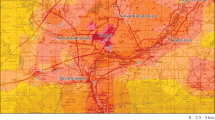Abstract
An analysis of statistical data has shown that most Russia’s cities with unfavorable ecological conditions refer to the Siberian Federal District. This is due to considerable amounts of atmospheric emissions from large industrial enterprises with imperfect equipment and technologies as well as to the unfavorable conditions of diffusion of dust and gas emissions. Attention is given to the role of nonferrous metallurgy, including aluminum smelting, in environmental impairment. It is shown that the pollutant emissions not only pollute the atmosphere, but also when returning to land surface, they alter the soil-geochemical habitat conditions for vegetation and animals and lower the quality of human life. The shifting of aluminum smelters to Siberia and the construction of major plants pose a threat of impairment in the ecological situation over a significant part of the territory, which is illustrated with the impact of pollutants from several aluminum smelters. Thus, in spite of the fact that the aluminum smelters of Khakassia are provided with up-to-date equipment, their 30-year-long operation has led to formation of a technogenic geochemical anomaly with an area of about 80 km2, containing 0.05 to 0.2% of the total amount of fluorine in the 0–15 cm topsoil, and water-soluble fluorine from 1 (10 mg/kg) to 3 MAC. The investigations show that the Soderberg method when used to obtain aluminum in large amounts (0.8–1 mln. t per year) is not as ecologically safe as advertised. It is therefore necessary to perfect the technologies used or to decrease the amount of aluminum produced.
Similar content being viewed by others
References
Kasimov, N.S., Ecogeochemistry of Landscapes, Moscow: IP Filimonov M.V., 2013 [in Russian].
Belozertseva, I.A. and Lopatina, D.N., Technogenic Impact of the Urbanized Territories of Siberia on Soils, Fundamental’nye Issledovaniya, 2015, issue 2, part 24, pp. 5397–5403 [in Russian].
State Report “On the Environmental Conditions and Protection in the Russian Federation in 2014”. URL: http://www.ecogosdoklad.ru (Accessed February 2, 2016) [in Russian].
Yakovlev, A.S., Plekhanova, I.O., Kudryashov, S.V., and Aimaletdinov, R.A., Assessment and Regulation of the Ecological State of Soils in the Impact Zone of Mining and Metallurgical Enterprises of Norilsk Nickel Company, Eurasian Soil Sci., 2008, vol. 41, issue 6, pp. 648–659.
Taran, R.O. and Elsukova, E.Yu., Content of Mobile Forms of Heavy Metals in the Influence Area of the Severonickel Complex (Kola Peninsula), Antropogennaya Transformatsiya Prirodnoi Sredy, 2015, no. 1, pp. 170–173 [in Russian].
Dauvalter, V.A. and Kashulin, N.A., Changes in Nickel and Copper Concentrations in the Surface Layers of Bottom Sediments of Lake Imandra for the Last Half a Century, Vestnik MGTU, 2015, vol. 18, no. 2, pp. 307–321 [in Russian].
Zaslavskaya, M.B. and Lapina, E.S., Technogenic Transformation of the Chemical Composition of Water Bodies in the Norilsk Hydrological Region, Vestnik Mosk. Univ., Seriya 5, Geografiya, 2008, no. 3, pp. 13–18 [in Russian].
Ziganshin, R.A., Voronin, V.I. and Karbainov, Yu.M., Forest Ecosystem Monitoring in Taimyr, Vestnik Krasnoyar. Agrar. Univ., 2011, no. 8, pp. 117–123 [in Russian].
Davydova, N.D. and Znamenskaya, T.I., Environmental Geochemical Assessment of Anthropogenous Impact of Various Pollutants of the Taiga Ecosystems by Aluminium Production, Mezhdunar. Zhurn. Prikladnykh i Fudamental’nykh Issledovanii, 2013., no. 8–1, pp. 43–45 [in Russian].
Rozhkov, A.S. and Mikhailova, T.A., The Effect of Fluorine Containing Emissions on Conifers, A.S. Isaev, Ed., Novosibirsk: Nauka, 1989 [in Russian].
Davydova, N.D., Transformation of Geochemical Environment in the Technogenic Anomaly, Problemy Biogeokhimii i Geokhiicheskoi Ekologii, 2012, no. 3, pp. 56–65 [in Russian].
Glazovskaya, M.A., The Geochemical Foundations of the Typology and Technique of Investigating Natural Landscapes, 2nd Ed., Smolensk: Oikumena, 2002 [in Russian].
Perel’man, A.I. and Kasimov, N.S., Landscape Geochemistry, Manual, 3rd Ed., Moscow: Astreya-1000, 1999 [in Russian].
Davydova, N.D., Znamenskaya, T.I. and Lopatkin, D.A., Landscape-Geochemical Approach to Solving Problems of Environmental Pollution, Contemp. Probl. Ecol., 2014, vol. 7, issue 3, pp. 345–352.
Davydova, N.D., Znamenskaya, T.I. and Lopatkin, D.A., Identification of Chemical Elements as Pollutants and Their Primary Distribuition in Steppes of the Southern Minusinsk Depression, Contemp. Probl. Ecol., 2013, vol. 6, issue 2, pp. 228–235.
Maximum Allowable Concentrations (MAC) of Chemical Substances in the Soil. Hygienic Normatives GN2.1.7.2041-06. URL: http://www.infosait.ru/?????_doc/46/46714 (Accessed February 1, 2016) [in Russian].
Krupkin, P.I. and Kositsina, A.A., Concerning Fluorine Pollution of the Soil in the Suburban Zone of the City of Krasnoyarsk, Vestnik Krasnoyar. Agrar. Univ., 2006, no. 10, pp. 162–169 [in Russian].
Sazonova, T.A., Pridacha, V.B., Terebova, E.N., Shreders, S.M., Kolosova, S.V., and Talanova, T.Yu., Morphophysiological Response of Scots Pine Trees to Industrial Pollution, Lesovedenie, 2005, no. 3, pp. 11–19 [in Russian].
Mikhailova, T.A., Berezhnaya, N.S. and Ignatyeva, O.V., Elemental Composition and Morphophysiological Parameters of the Needles of Scots Pine in Conditions of Technogenic Pollution, Irkutsk: Izd-vo Instituta Geografii SORAN, 2006 [in Russian].
Ilyina, S.P., Morphological Changes in Plants Used for Bioindication of Environmental Pollution, Proc. Conf. “Problems of Ecology and Ecological Education of Chelyabinsk Oblast” (Chelyabinsk), Chelyabinsk, 2001, pp. 37–38 [in Russian].
Pavlov, I.N., Woody Plants in Conditions of Technogenic Pollution, Ulan-Ude: Izd-vo Buryat. Nauch. Tsentra SORAN, 2005 [in Russian].
Pomazkina, L.V., Sokolova, L.G., Zorina, S.Yu., and Kovaleva, N.N., Integrated Assessment of Ecological Load on Agroecosystems Under Technogenic Pollution of Agrozems With Fluorides in the Baikal Natural Region, Agrokhimiya, 2011, no. 11, pp. 78–84 [in Russian].
Naprasnikova, E.V. and Makarova, A.P., Ecological- Microbiological and Biochemical Characteristics of Soil Cover Under Aerotechnogenic Contamination, Izv. Irk. Univ. Seriya Biologiya. Ekologiya, 2012, vol. 5, no. 2, pp. 19–26 [in Russian].
Davydova, N.D., Development of the Industry and Nature Management Problems in the South of the Minusinskaya Depression, Proc. 15th Meeting of Geographers of Siberia and the Far East (September 10–13, 2015, Ulan-Ude), Irkutsk: Izd-vo Instituta Geografii SORAN, 2015, pp. 399–401 [in Russian].
Author information
Authors and Affiliations
Corresponding author
Additional information
Original Russian Text © N.D. Davydova, T.I. Znamenskaya, 2016, published in Geografiya i Prirodnye Resursy, 2016, Vol. 37, No. 4, pp. 41-47.
Rights and permissions
About this article
Cite this article
Davydova, N.D., Znamenskaya, T.I. The geological problems of Siberia associated with the development of nonferrous metallurgy. Geogr. Nat. Resour. 37, 313–318 (2016). https://doi.org/10.1134/S1875372816040053
Received:
Published:
Issue Date:
DOI: https://doi.org/10.1134/S1875372816040053




